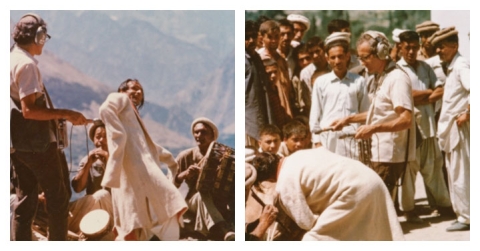This seminal album, inducted into the National Recording Registry in 2007, showcases the many beautiful musical styles found in Bali, which in its small area (only 2,147 square miles) contains a cornucopia of artistic wealth.
These recordings were made during my first field trip to Bali in September 1966. Since I was inexperienced, I failed to list the musical groups when this album was first released. The opening pieces, “Baris” and “Gambang Betjak,” were performed by the celebrated gamelan gong of the village of Peliatan. My notes do not list the performers of the Genggong, mentioning only that the recording was made in the puri (palace) in Ubud of the late Chokorde Gde Agung Sukawati, one of Bali’s great princely figures. The “Gambuh” music was recorded in the village of Batuan, whose musicians and performers are still famous throughout Bali for their mastery of this style. The “Barong” excerpt was recorded in the village of Singapadu. It is part of the Calonarang dance drama, in which the beneficent Barong confronts the evil witch Rangda. This music is provided not by a gamelan gong, but rather by an ensemble called Gamelan Pelegongan. The Lullaby was sung in the Ubud home of Antonio Blanco, a well-known artist, by his gorgeous 18-year-old sister-in-law, Rani, as she held Tony’s little son, Mario, on her lap, to get into the mood. “Margepati” was performed by the Gamelan Angklung of Bandjar Titih, Den Pasar, which then was a sleepy village, quite unlike today’s bustling metropolis. The “ketjak” (pronounced “kechak”; spelled kecak at the present time) was recorded in the village of Peliatan. My fragmentary notes do not list the musicians of the Gender Wayang ensemble, saying only that the recording was made in the puri of Ubud. Knowledgeable friends suggest that it was probably the group of I Made Grindem of Tegas, near Ubud.
I did not return to Bali until 1986, when I spent six weeks looking around, to see whether it would be worth mounting a serious recording effort the following year. While the sleepy island I remembered had been invaded by a horde of tourists, Balinese life and culture had endured. Satisfied that there was still plenty of excellent music, I returned the following year with an early generation of digital recording equipment, and spent five months working with many of the island’s best musicians. In 1994 I spent another three months in Bali, making yet more recordings of wonderful music. Some of these digital recordings can be heard on the Nonesuch album Bali: Gamelan and Kecak (79814-2).
—David Lewiston, Maui, September 2002
The thrilling sound of the Balinese orchestral style known as gamelan gong kebyar—which begins this record—is justly famous, for in no other music does one find such shimmering brilliance and tempestuous rhythms.
But it is less widely known that gamelan gong kebyar is only one of many beautiful musical styles found in Bali, which in its small area (only 2,147 square miles) contains a cornucopia of artistic wealth which would do honor to a country ten or twenty times its size.
Jawarharlal Nehru called Bali “the morning of the world” with good reason, for its some two-and-a-half million inhabitants lead unusually harmonious, satisfying lives refreshingly free of the tinsel that less wise countries mistake for civilization. For example, a farmer who works during the day in the lush rice paddies with which Bali’s hillsides are terraced may play an instrument in the village gamelan at night. His seven- or eight-year-old daughter, now playing a noisy game with her friends in the street, may at the very next moment emerge in the temple forecourt—which serves as a stage—as one of the gamelan’s star dancers.
DAVID LEWISTON, 1967
79714












